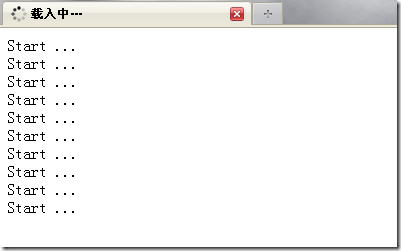Servlet 3.0筆記之異步請求相關方法和AsyncContext轉發等
在ServletRequest中增加的有關異步相關方法分為:
- startAsync(servletRequest, servletResponse) 傳入指定的request和response對象,便于在AsyncContext中重復使用(這樣被Filter、Servlet包裝過的請求、相應對象才會在異步的環境下繼續生效)。
- startAsync() 若request或者response被包裝,將失去預期的效果。
- isAsyncSupported() 和 isAsyncStarted()
輔助性的方法,用于判斷當前請求是否支持異步或者異步已經開始。 - getAsyncContext()
需要在異步啟動之后才能夠訪問,否則會報異常。
在AsyncContext中分發的方法有三個,不太容易區分:
- AsyncContext.dispatch()
若當前AsyncContext由ServletRequest.startAsync(ServletRequest, ServletResponse)方法啟動,返回的地址可以通過HttpServletRequest.getRequestURI()得到。
否則,分發的地址則是當前URL request對象最后一次分發的地址。
雖有些拗口,兩者分發的地址大部分情況下一致;但盡量使用帶有參數的異步上下文啟動器。
如本例中請求/asyncDispatch2Async?disUrl=self,執行dispatch()方法之后,自身會再次分發到自身,包括傳遞的參數。 - AsyncContext.dispatch(String path)
等同于ServletRequest.getRequestDispatcher(String),算是一個快捷方法。
可以轉向一個同步或異步的servlet,或者JSP,或其它資源地址等。
- AsyncContext.dispatch(ServletContext context, String path)
請求的地址將在給定的上下文里面(ServletContext),有有可能傳入的上下文與當前站帶你應用的上下文有所區別。
展示一個較為有趣、但沒有多少實際意義的小示范:
/**
* 異步上下文的轉向分發
*
* @author yongboy
* @date 2011-1-14
* @version 1.0
*/
@WebServlet(urlPatterns = { "/asyncDispatch2Async" }, asyncSupported = true)
public class AsyncContextDispatch2AsyncServlet extends HttpServlet {
private static final long serialVersionUID = 46172233331022236L;
private static final Log log = LogFactory
.getLog(AsyncContextDispatch2AsyncServlet.class);
protected void doGet(HttpServletRequest request,
HttpServletResponse response) throws ServletException, IOException {
response.setHeader("Cache-Control", "private");
response.setHeader("Pragma", "no-cache");
response.setHeader("Connection", "Keep-Alive");
response.setHeader("Proxy-Connection", "Keep-Alive");
response.setContentType("text/html;charset=UTF-8");
PrintWriter out = response.getWriter();
out.println("
Start ...
");
out.flush();
if (!request.isAsyncSupported()) {
log.info("the servlet is not supported Async");
return;
}
request.startAsync(request, response);
if (request.isAsyncStarted()) {
AsyncContext asyncContext = request.getAsyncContext();
asyncContext.setTimeout(1L * 60L * 1000L);// 60sec
new CounterThread(asyncContext).start();
} else {
log.error("the ruquest is not AsyncStarted !");
}
}
private static class CounterThread extends Thread {
private AsyncContext asyncContext;
public CounterThread(AsyncContext asyncContext) {
this.asyncContext = asyncContext;
}
@Override
public void run() {
int interval = 1000 * 20; // 20sec
try {
log.info("now sleep 20s, just as do some big task ...");
Thread.sleep(interval);
log.info("now dispatch to another Async Servlet");
ServletRequest request = asyncContext.getRequest();
String disUrl = request.getParameter("disUrl");
if (StringUtils.isBlank(disUrl)) {
disUrl = "/demoAsyncLink";
}
if (disUrl.endsWith(".jsp")) {
request.setAttribute("dateStr", DateFormatUtils.format(
System.currentTimeMillis(), "yyyy-MM-dd HH:mm:ss"));
}
log.info("disUrl is : " + disUrl);
// 將當前異步上下文所持有的request, response分發給Servlet容器
if (StringUtils.equals("self", disUrl)) {
// 將分發到自身,即當前異步請求地址
asyncContext.dispatch();
} else {
// 將分發到指定的路徑
asyncContext.dispatch(disUrl);
}
} catch (InterruptedException e) {
e.printStackTrace();
}
}
}
}
當前請求完成之后,將分發到下一個請求上面,若都是異步的Servlet,則很好的組成了異步Servlet請求鏈。
有趣的地方在于,異步上下文環境可以分發到下一個異步或同步的servlet、jsp、html等資源。若訪問類似于如下地址,當前URL永遠不會斷開,又一個永動機,除非網絡鏈接出錯或者服務器關閉。
http://localhost/servlet3/asyncDispatch2Async?disUrl=self
一個視圖:
上面的異步Servlet總是在不斷的請求自我,成為了一個永動機;為disUrl傳入要轉發到的異步或同步的資源地址,組成一個鏈的模式,相當的簡單輕松。
posted on 2011-01-17 21:07 nieyong 閱讀(12143) 評論(0) 編輯 收藏 所屬分類: Servlet3




